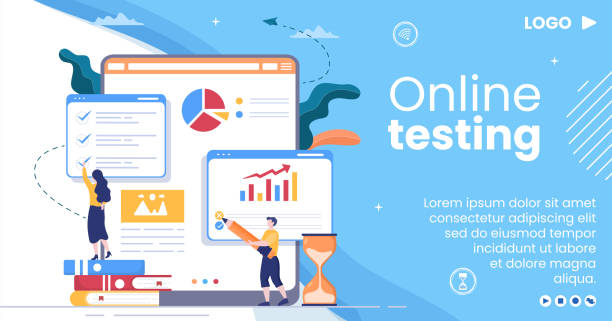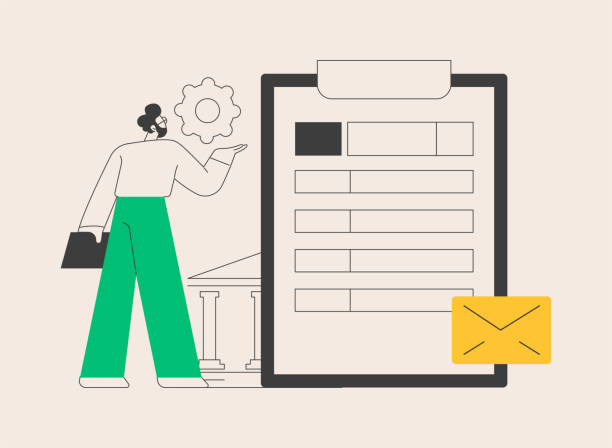Introduction to the Importance of User-Friendly Website Design

In today’s digital world, where competition for user attention has become more intense than ever, user-friendly website design is not just an advantage, but an undeniable necessity.
This approach goes beyond the aesthetic appearance of the website, focusing on the user’s overall experience from the moment they enter the site until they reach their final goal.
A user-friendly site is one that is easy to navigate, where information is simply found, and interaction with it is enjoyable.
This approach not only increases user satisfaction but also directly impacts conversion rates, customer retention, and brand credibility.
The importance of this issue is such that many large businesses and companies allocate a significant portion of their investment to improving user experience (UX) and user interface (UI) design.
This chapter explains and educates on the definition and importance of #UserFriendlyWebsiteDesign.
If your website offers easy usability and a pleasant experience, users will be more inclined to stay, explore, and ultimately perform your desired actions.
This is particularly vital in the fields of #ECommerce and #OnlineServices, where every second of delay or any complexity in the process can lead to losing a customer.
For this reason, a deep understanding of user needs and behaviors is central to user-friendly website design.
Good design should meet user expectations and provide an environment where the user feels comfortable and in control.
This plays a significant role in attracting and retaining audiences in the long run.
Does your company’s website create a professional and lasting first impression in the minds of potential customers? Rasawab, with its professional corporate website design, not only represents your brand’s credibility but also opens a path for your business growth.
✅ Create a powerful and reliable brand image
✅ Attract target customers and increase sales
⚡ Get free consultation
Fundamental Principles of User Interface and User Experience Design

To achieve user-friendly website design, it is necessary to be familiar with the fundamental principles of UI (User Interface) and UX (User Experience).
These principles form the backbone of any successful website.
The most important of these principles include Usability, which refers to the simplicity and efficiency of using the site; Accessibility, which ensures the site is usable for everyone, including people with disabilities; and finally, attractive and consistent visual design.
In UI design, the focus is on visual and interactive elements such as buttons, forms, typography, and page layout.
The goal is for everything to be beautiful and at the same time usable.
In contrast, UX deals with the user’s overall feeling and experience; are the processes logical? Do users achieve their goals? This section will professionally and educationally help you gain a better understanding of these key concepts and implement them in your projects.
Consistency or Uniformity in design is another important principle.
This means that similar elements should function and appear the same throughout the website, so users are not confused.
Appropriate feedback to users after each action (e.g., clicking a button) is also crucial for them to know the success or failure of their operation.
All of these work together to form a user-friendly website design that not only meets user needs but also exceeds their expectations.
Considering user psychology in choosing colors, fonts, and element arrangements can also have a profound impact on user experience.
Understanding these principles is the first step to creating websites that users truly love to use.
Understanding the Target Audience for Effective Design

One of the most important steps in the user-friendly website design process is a precise understanding of the target audience.
Without a deep understanding of user needs, goals, behaviors, and challenges, you cannot design a website that is truly useful and attractive to them.
This stage includes market research, interviews with potential users, and analysis of existing data.
Creating “Personas” or hypothetical user characters is one of the effective methods for visualizing audiences.
Personas help designers look at users with greater empathy and make design decisions based on their real needs.
This section analytically and expertly addresses the importance and methods of understanding the audience and provides guidance for creating user personas.
Here is a simple table to help build a persona:
| Feature | Description |
|---|---|
| First and Last Name | A hypothetical name for the person (e.g., Sara Mohammadi) |
| Demographics | Age, occupation, education, marital status, place of residence |
| Goals and Needs | What do they want to achieve? What information do they need? |
| Online Behaviors | Internet usage habits, devices used, preferred platforms |
| Pain Points | Challenges and obstacles they face (e.g., inability to find information, process complexity) |
| Motivational Quotes | Phrases that reflect their mindset or perspective. |
Understanding the User Journey and their touchpoints with the website is also of high importance.
This allows you to identify potential obstacles and propose solutions for improving the overall experience.
By focusing on this information, your user-friendly site design will be more targeted and effective, leading to better results.
Information Architecture and Intuitive Navigation

One of the main pillars of user-friendly website design is the Information Architecture (IA) and the site’s Navigation system.
Information Architecture deals with organizing and labeling content in a way that users can easily find what they are looking for.
A logical and hierarchical structure guides users in the right direction and prevents their confusion.
This is crucial for any website, from a simple blog to a complex e-commerce platform.
The navigation system must be intuitive and predictable.
Clear menus, meaningful internal links, and the use of breadcrumbs are examples of effective navigation.
This chapter will guide and professionally teach you how to create a strong information architecture and a smooth navigation system for your website.
Using an efficient search bar is also part of navigation.
When users cannot easily move around your site or find information, they quickly leave the site.
Therefore, investing in designing simple and logical navigation will have a high return in retaining users.
Also, it should be noted that users access your site from various devices with different screen sizes, so navigation must be optimized and user-friendly across all these devices.
Proper implementation of these principles ensures that your website not only looks good but also has high functionality and helps users achieve their goals.
Remember that #simplicity and #clarity in information architecture are key to achieving a truly user-friendly website.
Are you bothered by losing customers who visited your site to buy?
Rasawab is your specialized solution for a successful online store.
✅ Significantly increase your online sales
✅ Build trust and professional branding among customers
⚡ Get free consultation from Rasawab specialists!
Visual Design and Attractive User Interface

After structuring information and navigation, it’s time for visual design and user interface (UI).
Website aesthetics play a significant role in creating a sense of trust and professionalism and can greatly influence the user’s first impression.
This aspect of user-friendly website design includes choosing an appropriate color palette, fonts, images, icons, and overall page layout.
The goal is for the website not only to look beautiful but also to have high readability and usability.
Using Responsive Design is also essential so that your website displays correctly on any device, from desktops to mobiles and tablets.
This chapter professionally and explanatorily addresses how to create an attractive and effective visual design.
The balance between beauty and functionality forms the core of a user-friendly website design.
Visual elements should be arranged to guide the user towards important information and convey the main message without causing distraction.
White Space plays an important role in increasing readability and aesthetics, as it allows the user’s eye to rest and highlights elements.
Also, using high-quality and relevant images and videos can contribute to visual appeal and conveying meaning.
Modern UI design emphasizes simplicity, minimalism, and purposeful use of animations and micro-interactions that enrich the user experience.
Do not forget that the main goal is to create a user-friendly interface that is both visually appealing and efficient.
Font selection must be done carefully, as text readability is very important.
The Importance of Website Loading Speed and Performance

In the age of instant information, website loading speed is one of the most important factors affecting user experience and user-friendly website design.
Studies have shown that users expect a website to load in less than three seconds, otherwise the likelihood of leaving the site increases.
Slow speed not only causes user dissatisfaction but can also negatively affect the site’s ranking in search engines.
Image optimization, code compression, using a CDN (Content Delivery Network), and choosing suitable hosting are among the actions that can help improve website speed.
This chapter reports and professionally addresses the latest techniques and tools for optimizing website performance and highlights its importance in retaining users.
Recent news in the web field shows that Google Core Web Vitals, as key metrics for measuring user experience, directly impact site rankings, of which loading speed is an integral part.
Therefore, continuous monitoring and improvement of these metrics are crucial for any website seeking success and a user-friendly website design.
Optimizing images with new formats like WebP, reducing HTTP requests, optimizing JavaScript and CSS, and using browser caching are among the technical solutions that significantly affect site speed.
A fast website not only increases user satisfaction but also helps maintain brand credibility and increase conversion rates.
Optimal performance of your website is a sign of respect for users’ time and encourages them to visit your site again and again.
This aspect of user-friendly website design is often overlooked but has a great impact on overall success.
Website Accessibility for All Users

Accessibility is one of the most important, yet sometimes overlooked, aspects of user-friendly website design.
An accessible website ensures that everyone, regardless of their abilities or disabilities (visual, auditory, motor, cognitive), can easily use it.
This is not only an ethical responsibility but also a legal requirement in many countries.
Designing for accessibility includes providing alternative text for images (alt text), using appropriate color contrast, keyboard navigation, and supporting assistive technologies like screen readers.
This chapter will educate and guide you to design a website that is truly for everyone.
Here is a basic checklist for website accessibility:
| Item | Description |
|---|---|
| Alt Text for Images | Do all images have appropriate and descriptive alt tags? |
| Sufficient Color Contrast | Do text and background colors have enough contrast for easy readability? (WCAG 2.1 AA) |
| Keyboard Navigation | Are all clickable and interactive elements (links, buttons, forms) accessible and activatable with the keyboard? |
| Clear Descriptions for Links and Buttons | Do links and buttons provide clear descriptions of their destination or function? (Without using “click here”) |
| Correct Use of Semantic HTML Tags | Is the page structure correctly implemented with semantic tags (h1-h6, p, ul, li, header, nav, main, footer)? |
| Captions and Transcripts for Audio and Video Content | Are captions or text transcripts provided for videos and podcasts? |
By implementing these principles, you not only contribute to a more inclusive society but also expand your user base and help adhere to international standards.
Designing a website that is usable for everyone is a prime example of true user-friendly website design.
Paying attention to these points ensures that your website is not only legally compliant but also recognized by the audience as a responsible and comprehensive platform.
W3C Web Accessibility Initiative (WAI) is an excellent resource for more information in this area.
The Importance of Content in User Experience

Content is king; this statement applies not only to SEO but also to user-friendly website design.
Quality, relevant, and understandable content is the cornerstone of any successful user experience.
A user-friendly website provides content that answers user questions, provides the information they need, and guides them towards their goals.
This includes clear and concise texts, illustrative images, instructional videos, and clear Calls to Action.
This chapter thought-provokingly and analytically addresses how content can help improve user experience and offers solutions for producing effective content.
Is your content engaging and digestible enough? Is it understandable to your different audiences? These are questions that need to be answered.
Proper content structuring using headings, short paragraphs, and lists significantly increases readability.
Using an appropriate and friendly tone can establish a deeper connection with the user.
Clear and concise content saves users from confusion and helps them quickly access the information they need.
Also, regular content updates demonstrate your site’s dynamism and credibility and encourage users to return for new content.
Therefore, part of a user-friendly website design is meticulous planning for producing and managing valuable content that meets user needs and gives them a sense of satisfaction.
Your content should not only be informative but also presented in a way that users enjoy reading it.
Do you know that customers’ first impression of your company is your website? With a powerful corporate website from Rasawab, multiply your business credibility!
✅ Exclusive and eye-catching design tailored to your brand
✅ Improved user experience and increased customer attraction
⚡ Get free consultation!
Continuous Testing and Optimization

After initial design and implementation, the work of user-friendly website design does not end.
In fact, it is a continuous process that includes testing, feedback collection, and continuous optimization.
User Testing, A/B testing, and analysis of user behavioral data (e.g., via Google Analytics) are vital tools for identifying the strengths and weaknesses of your website.
This chapter guides and professionally addresses the importance and methods of continuous testing and optimization.
Any change you make to the website should aim to improve user experience and increase site efficiency.
User feedback is a treasure trove of information that can help you better understand their needs and expectations.
Encouraging users to provide comments and suggestions, and then acting on them, demonstrates your commitment to a user-friendly website design.
Continuous optimization includes improving the user interface, content, speed, and accessibility.
This feedback and improvement cycle ensures that your website is always aligned with changing user needs and becomes more optimized over time.
#Iteration and #improvement are essential in the website design process.
Even the smallest changes can have significant impacts on conversion rates and user satisfaction.
Therefore, a team committed to user-friendly website design is constantly monitoring and analyzing their site’s performance to provide the best possible experience.
Accepting the fact that your website is never “complete” but is always evolving is key to long-term success.
Security and Privacy in User Experience

Alongside all aesthetic and functional aspects, security and privacy are of paramount importance in user-friendly website design.
Users must feel secure that their personal information is protected on your website and their privacy is respected.
Using security protocols such as HTTPS, SSL certificates, and transparency about how data is collected and used builds user trust.
Failure to comply with these can quickly lead to loss of trust and users leaving the site.
This chapter reports and explains the importance of security and privacy on websites and provides guidance for increasing user trust.
Recent news about #PrivacyBreaches and #CyberAttacks has increased public awareness of these issues.
Therefore, a user-friendly website design must address these concerns and reassure users.
Providing clear and understandable privacy policies, transparent options for data and communication control, and also using advanced security measures are all part of these principles.
User trust in your website is the foundation upon which all other aspects of user experience are built.
If users do not trust the security of their information, no matter how beautiful the interface and easy the navigation, they will still refrain from using your site.
Therefore, in the user-friendly website design process, security and transparency in privacy must be prioritized to provide a complete and reliable user experience.
Paying attention to GDPR regulations and other relevant privacy laws is also essential for international websites.
Frequently Asked Questions
And other services of Rasawab Advertising Agency in the field of advertising
- Smart Advertising Campaign: A fast and efficient solution for digital branding with a focus on attractive UI design.
- Smart Marketing Automation: A novel service to increase customer acquisition through SEO-driven content strategy.
- Smart Content Strategy: Transform click-through rates with the help of Google Ads management.
- Smart Custom Software: Professional optimization for customer behavior analysis using attractive UI design.
- Smart Direct Marketing: Designed for businesses seeking to improve SEO ranking through precise audience targeting.
And over hundreds of other services in the field of internet advertising, advertising consultation, and organizational solutions
Internet Advertising | Advertising Strategy | Advertorials
References
Principles of User Experience DesignResponsive Design GuideBest UI/UX PracticesWebsite Performance and User Experience
? Rasawab Afarin, a leading digital marketing agency, paves the way for your business success. From professional e-commerce website design to comprehensive SEO strategies, we are ready to distinguish your brand in the online space and elevate it to the top.
📍 Tehran, Mirdamad Street, next to Bank Markazi, Kazerun Jonoubi Alley, Ramin Alley, No. 6
